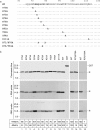Amino acid residues critical for RNA-binding in the N-terminal domain of the nucleocapsid protein are essential determinants for the infectivity of coronavirus in cultured cells
- PMID: 16971454
- PMCID: PMC1635287
- DOI: 10.1093/nar/gkl650
Amino acid residues critical for RNA-binding in the N-terminal domain of the nucleocapsid protein are essential determinants for the infectivity of coronavirus in cultured cells
Abstract
The N-terminal domain of the coronavirus nucleocapsid (N) protein adopts a fold resembling a right hand with a flexible, positively charged beta-hairpin and a hydrophobic palm. This domain was shown to interact with the genomic RNA for coronavirus infectious bronchitis virus (IBV) and severe acute respiratory syndrome coronavirus (SARS-CoV). Based on its 3D structure, we used site-directed mutagenesis to identify residues essential for the RNA-binding activity of the IBV N protein and viral infectivity. Alanine substitution of either Arg-76 or Tyr-94 in the N-terminal domain of IBV N protein led to a significant decrease in its RNA-binding activity and a total loss of the infectivity of the viral RNA to Vero cells. In contrast, mutation of amino acid Gln-74 to an alanine, which does not affect the binding activity of the N-terminal domain, showed minimal, if any, detrimental effect on the infectivity of IBV. This study thus identifies residues critical for RNA binding on the nucleocapsid surface, and presents biochemical and genetic evidence that directly links the RNA binding capacity of the coronavirus N protein to the viral infectivity in cultured cells. This information would be useful in development of preventive and treatment approaches against coronavirus infection.
Figures





Similar articles
-
The nucleocapsid protein of coronavirus infectious bronchitis virus: crystal structure of its N-terminal domain and multimerization properties.Structure. 2005 Dec;13(12):1859-68. doi: 10.1016/j.str.2005.08.021. Structure. 2005. PMID: 16338414 Free PMC article.
-
Anti-infectious bronchitis virus (IBV) activity of 1,8-cineole: effect on nucleocapsid (N) protein.J Biomol Struct Dyn. 2010 Dec;28(3):323-30. doi: 10.1080/07391102.2010.10507362. J Biomol Struct Dyn. 2010. PMID: 20919748
-
Characterisation of the RNA binding properties of the coronavirus infectious bronchitis virus nucleocapsid protein amino-terminal region.FEBS Lett. 2006 Oct 30;580(25):5993-8. doi: 10.1016/j.febslet.2006.09.052. Epub 2006 Oct 2. FEBS Lett. 2006. PMID: 17052713 Free PMC article.
-
An arginine-to-proline mutation in a domain with undefined functions within the helicase protein (Nsp13) is lethal to the coronavirus infectious bronchitis virus in cultured cells.Virology. 2007 Feb 5;358(1):136-47. doi: 10.1016/j.virol.2006.08.020. Epub 2006 Sep 18. Virology. 2007. PMID: 16979681 Free PMC article.
-
Role of phosphorylation clusters in the biology of the coronavirus infectious bronchitis virus nucleocapsid protein.Virology. 2008 Jan 20;370(2):373-81. doi: 10.1016/j.virol.2007.08.016. Epub 2007 Nov 1. Virology. 2008. PMID: 17931676 Free PMC article.
Cited by
-
Identification of two ATR-dependent phosphorylation sites on coronavirus nucleocapsid protein with nonessential functions in viral replication and infectivity in cultured cells.Virology. 2013 Sep;444(1-2):225-32. doi: 10.1016/j.virol.2013.06.014. Epub 2013 Jul 9. Virology. 2013. PMID: 23849791 Free PMC article.
-
A Comprehensive View on the Protein Functions of Porcine Epidemic Diarrhea Virus.Genes (Basel). 2024 Jan 26;15(2):165. doi: 10.3390/genes15020165. Genes (Basel). 2024. PMID: 38397155 Free PMC article. Review.
-
Crystal structure-based exploration of the important role of Arg106 in the RNA-binding domain of human coronavirus OC43 nucleocapsid protein.Biochim Biophys Acta. 2013 Jun;1834(6):1054-62. doi: 10.1016/j.bbapap.2013.03.003. Epub 2013 Mar 15. Biochim Biophys Acta. 2013. PMID: 23501675 Free PMC article.
-
Formation of stable homodimer via the C-terminal alpha-helical domain of coronavirus nonstructural protein 9 is critical for its function in viral replication.Virology. 2009 Jan 20;383(2):328-37. doi: 10.1016/j.virol.2008.10.032. Epub 2008 Nov 20. Virology. 2009. PMID: 19022466 Free PMC article.
-
Binding of the 5'-untranslated region of coronavirus RNA to zinc finger CCHC-type and RNA-binding motif 1 enhances viral replication and transcription.Nucleic Acids Res. 2012 Jun;40(11):5065-77. doi: 10.1093/nar/gks165. Epub 2012 Feb 22. Nucleic Acids Res. 2012. PMID: 22362731 Free PMC article.
References
-
- Chang C.K., Sue S.C., Yu T.H., Hsieh C.M., Tsai C.K., Chiang Y.C., Lee S.J., Hsiao H.H., Wu W.J., Chang C.F., et al. The dimer interface of the SARS coronavirus nucleocapsid protein adapts a porcine respiratory and reproductive syndrome virus-like structure. FEBS Lett. 2005;579:5663–5668. - PMC - PubMed
Publication types
MeSH terms
Substances
LinkOut - more resources
Full Text Sources
Other Literature Sources
Miscellaneous

